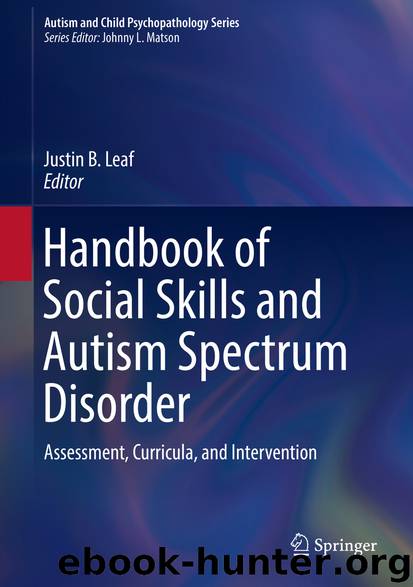Handbook of Social Skills and Autism Spectrum Disorder by Justin B. Leaf

Author:Justin B. Leaf
Language: eng
Format: epub
Publisher: Springer International Publishing, Cham
13.16 Clinical Implications and Recommendations
From the above description of how an integrated intervention that encompasses both developmental science and learning science approaches the opportunity to support the social development of young children with ASD, several points have likely emerged for the reader. One involves the many domains of skills, development, and learning that underlie children’s progress in learning to be responsive social partners with others. Of great importance is the skilled use of both intentional verbal communication and its nonintentional coordination with nonverbal communicative cues in the gestural, postural, and affective domains. Another involves a skilled and flexible repertoire of age-appropriate social and object oriented games, vocabulary, and use of learning and play materials, and activities of all types that allow children to participate in the same activities as other children at similar skill levels. A third is the ability to engage reciprocally with others during all these activities, watching what others do, imitating them flexibly, seeing other’s goals and adding to them, being able to follow a partner as well as to lead, requesting to join in, inviting others to join, catching others’ affective displays and mirroring them back, and sharing emotion messages and materials with others. A fourth involves knowledge of what others think, feel, and experience at an age-appropriate level so that one can appreciate the other’s perspective. Doubtless there are more. There is no one discipline of training that adequately prepares a single professional with the expertise to assess social participation in all these ways and develop appropriate treatment plans. The complexity of social development is best supported by a treatment team that spans many different areas of expertise (e.g., communication, motor development and praxis, early cognitive development, early childhood education, behavior analysis, and countless others).
(1) One implication and recommendation is for interdisciplinary input in developing treatment plans and assessing treatment progress in the social domain.
The second clinical implication and recommendation follows closely with the first. In order to develop an adequate treatment plan for social development for an individual child, a wide range of developmental and behavioral skills need to be assessed, built upon, and brought together in moment-by-moment interactions with other children.
(2) The interdisciplinary knowledge needed to develop an individualized plan for supporting social development requires comprehensive assessment data of a child’s current abilities across the many domains of development.
The last clinical implication and recommendation addressed here involves the contexts in which children develop their social abilities. In American life today, the give and take of family life represent the first social environment of all children, beginning with parents, and adding older and younger siblings and other relatives to the mix as infants become toddlers. Peer groups of same age mates in preschool, play groups and playdates, and recreational and church groups represents the second social environment of preschoolers. If we are to prepare young children with ASD for life in the community at age 5, at 15, and at 25, we need to begin at home and in other contexts with same age mates, where the expectations, practices, and cultural rules are most clearly expressed.
Download
This site does not store any files on its server. We only index and link to content provided by other sites. Please contact the content providers to delete copyright contents if any and email us, we'll remove relevant links or contents immediately.
| Grief & Bereavement | Hospice Care |
| Pet Loss | Suicide |
They Both Die at the End by Adam Silvera(9771)
Thirteen Reasons Why by Jay Asher(8846)
The Space Between by Michelle L. Teichman(6894)
Suicide Notes by Michael Thomas Ford(4788)
Tuesdays with Morrie by Mitch Albom(4732)
Suicide: A Study in Sociology by Emile Durkheim(2989)
The Checklist Manifesto by Atul Gawande(2810)
Tuesdays With Morrie by Mitch Albom(2723)
In the Woods by Tana French(2561)
Bossypants by Tina Fey(2498)
Robin by Dave Itzkoff(2413)
Olive Kitteridge by Elizabeth Strout(2339)
No Ashes in the Fire by Darnell L Moore(2318)
Reservoir 13 by Jon McGregor(2264)
End of Days by Sylvia Browne(2147)
All Things New by John Eldredge(2134)
Bus on Jaffa Road by Mike Kelly(2124)
Scar Tissue by Anthony Kiedis(2109)
No Time to Say Goodbye(2081)
